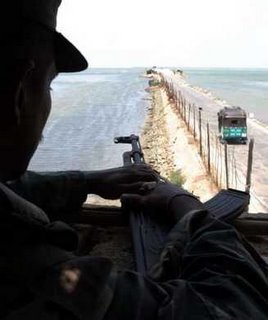Broken Pieces
Economist
May 18, 2006
Sri Lanka
A 23-year-old war turns bloody again

MORE than 200 people, mostly civilians, have been killed in the past month alone in Sri Lanka's rekindled civil war, and more than 20,000 have been displaced from their homes. A ceasefire agreement, signed in 2002, is still notionally in force between the government and the Liberation Tigers of Tamil Eelam, who have been fighting for a homeland for the Tamil minority in the north and east of the island. But respective spokesmen for the Tigers and for the Swedish general leading a group of Nordic ceasefire monitors have used the same phrase to describe its current status: “low-intensity war”.
Even that is beginning to sound like a euphemism. On May 13th, on Kayts, a tiny island off the north-western coast, 13 Tamils, including a baby and a child, were shot dead by unknown gunmen. The government has condemned the slaughter. But the Tigers have accused its navy of responsibility. Two days earlier, the Tigers had attacked a naval convoy escorting a ferry with more than 700 soldiers on board, killing at least 17 sailors, and losing perhaps 50 “Sea Tigers”.
That blatant violation of the ceasefire has forced the monitors to suspend their work at sea. No government recognises the Tigers' claim to sovereignty over waters off the territory they control. But it is part of their attempt to achieve symbolic equality with the government should peace talks, stalled since February, ever resume. They also rely on the sea to smuggle in weapons and other supplies, and to transport fighters to and from their areas in the north and in the east, which are in places separated by government-controlled territory.

This constraint is complicating the Tigers' struggle with a splinter group in the east, led by a commander known simply as Karuna, who split from the northern leadership two years ago. The Tigers insist—plausibly—that the army is helping Karuna and that it must disarm his faction before peace talks can resume.
This is the Tigers' pretext for stepping up their attacks, which included an attempt last month to kill the Sri Lankan army commander in a suicide bombing in the capital, Colombo. The army retaliated with air raids on Tiger positions, in which civilians also suffered. Earlier in April, government soldiers had tolerated mob violence against Tamils by members of the Sinhalese majority in the eastern town of Trincomalee. All of this tends to make even Tamils who do not support the Tigers turn to them for protection.
Both sides are trying to strengthen their position on the ground before they start talking peace again. The risk, however, is that the tit-for-tat exchanges will gather unstoppable momentum and that a low-intensity war will end not in peace talks but in a high-intensity one.
Copyright © 2006 The Economist Newspaper and The Economist Group. All rights reserved.

0 Comments:
Post a Comment
<< Home